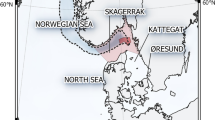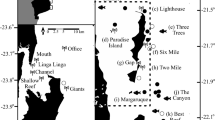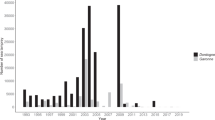Abstract
Cod (Gadus morhua) are bottom-living, predatory fish of considerable commercial importance1, but surprisingly little is known of what cod do for most of their time because it is difficult and costly to study the behaviour of fish at sea2,3. Here we use electronic data-storage tags to investigate the behaviour of cod in the North Sea and in the Irish Sea and find that there are marked differences in the activity of fish in the two regions. This difference could be explained by dissimilar foraging ecology and may have implications for the future management of severely depleted cod stocks.
Similar content being viewed by others
Main
Evidence from acoustic4 and fishing5 surveys can be used to infer variations in behaviour patterns between different cod stocks, but behavioural data have never been collected simultaneously from individual fish from different stocks over timescales appropriate to fisheries management6. In March–April 1999, we tagged 78 cod (each over 50 cm long) with electronic data-storage devices: 58 were in the southern North Sea and 20 in the central Irish Sea. Twenty-two tags have so far been returned from fish caught in the North Sea, providing over 1,500 days of data, and four have been returned from the Irish Sea (over 750 days of data).
By using the depth record to estimate a cod's activity, we found that Irish Sea cod were extremely active at all times (dark regions in Fig. 1a), showing no discernible evidence of diurnal or seasonal patterns. North Sea cod were also very active during April and May, but in June all fish still at liberty (8 fish) showed a marked reduction in vertical movement, and in July they spent much or all of their time on the sea floor. Fish still free in August and September (5 fish) became active at night, and during October and November (2 fish) they returned to activity levels seen in the previous April and May (Fig. 1a). In a follow-up experiment in 2000, we monitored the position of North Sea cod implanted with individually coded acoustic tags and demonstrated that their range of movement during the summer months (mid-June to mid-August) was less than 1 km (Fig. 1b).
a, Activity between April and November 1999. Active and inactive states of each individual were determined from the depth (measured every 10 min) record of its tag (Lotek Marine Technologies LTD100). When an individual was 'inactive' on the seabed, its tag recorded only the smooth changes in pressure resulting from the rise and fall of the tide. Individuals were classed as 'active' when vertical movements were more rapid or irregular than could be accounted for by the tide alone. For each hour of the day, summed hourly activity held a value between zero (white; inactive) and six (black; most active). Each fish's activity record is shown as a double-plot actogram, with data in 48-h periods along the x-axis and days of the year along the y-axis. b, Residence on summer feeding grounds in the North Sea in 2000. A moored listening station continuously monitored the presence (bars) or absence (no bar) of four individuals implanted with individually coded acoustic tags. The listening station had a detection range of 500 m. The control tag was located within 200 m of the listening station for the duration of the experiment.
The technology is not yet available to measure the feeding behaviour of fish directly in the field. However, our results indicate that North Sea cod reduce their foraging movements during the summer months. This observation challenges the explicit assumptions of multispecies management models7 that cod are active and forage over substantial geographical areas. By contrast, Irish Sea cod appear to be active throughout the spring and summer. We propose that these differences in activity could be behavioural responses to variations in the distribution and abundance of prey species between sea basins, an idea we intend to test by using a tag equipped with a feeding sensor to investigate the feeding dynamics of free-ranging cod.
Low spawning-stock biomass, increased seawater temperatures and high fishing rates have put North Sea and Irish Sea cod stocks under great pressure8,9. Special technical conservation measures designed to provide protection for cod have been specified in recovery plans announced in 2000 for the Irish Sea10 and recently for the North Sea11. A significant component of these plans involves closing particular areas of sea to fishing for short periods of time.
Our findings show that the activity of cod varies through the year, and that seasonal patterns of activity differ between stocks. To our knowledge, this is the first time that the activity patterns of cod from different stocks have been described over extended periods at such a fine temporal and spatial scale. This understanding will improve our ability to predict the effectiveness of fisheries management by closed areas in different regions.
References
Yearbook of Fishery Statistics 84 (FAO, Rome, 1997).
Godø, O. R. & Michalsen, K. Fisheries Res. 48, 127–140 (2000).
Metcalfe, J. D. & Arnold, G. P. Nature 387, 665–666 (1997).
Wroblowski, J. S., Nolan, B. G., Rose, G. A. & deYoung, B. Fisheries Res. 45, 51–59 (2000).
Beamish, F. W. H. J. Fish. Res. Bd Can. 23, 109–139 (1966).
Arnold, G. P., Walker, M. G., Emerson, L. S. & Holford, B. H. Ices J. Mar. Sci. 51, 207–232 (1994).
Magnusson, K. G. Rev. Fish. Biol. Fish. 5, 195–212 (1995).
Report of the ICES Advisory Committee on Fisheries Management 236 (ICES, Copenhagen, 1999); http://www.ices.dk
O'Brien, C. M., Fox, C. J., Planque, B. & Casey, J. Nature 404, 142 (2000).
Commission Regulation EC No. 304/2000. Official Journal. L 35/10 (2000).
Commission Regulation EC No. 259/2001. Official Journal. L 39/7 (2001).
Author information
Authors and Affiliations
Corresponding author
Rights and permissions
About this article
Cite this article
Righton, D., Metcalfe, J. & Connolly, P. Different behaviour of North and Irish Sea cod. Nature 411, 156 (2001). https://doi.org/10.1038/35075667
Issue Date:
DOI: https://doi.org/10.1038/35075667
This article is cited by
-
Addressing the dichotomy of fishing and climate in fishery management with the FishClim model
Communications Biology (2022)
-
The behavioural diversity of Atlantic cod: insights into variability within and between individuals
Reviews in Fish Biology and Fisheries (2018)
-
Evidence from data storage tags for the presence of lunar and semi-lunar behavioral cycles in spawning Atlantic cod
Environmental Biology of Fishes (2015)
-
Changes in the timing of otolith zone formation in North Sea cod from otolith records: an early indicator of climate-induced temperature stress?
Marine Biology (2011)
-
Individual-based movement behaviour in a simple marine reserve—fishery system: why predictive models should be handled with care
Hydrobiologia (2008)
Comments
By submitting a comment you agree to abide by our Terms and Community Guidelines. If you find something abusive or that does not comply with our terms or guidelines please flag it as inappropriate.




